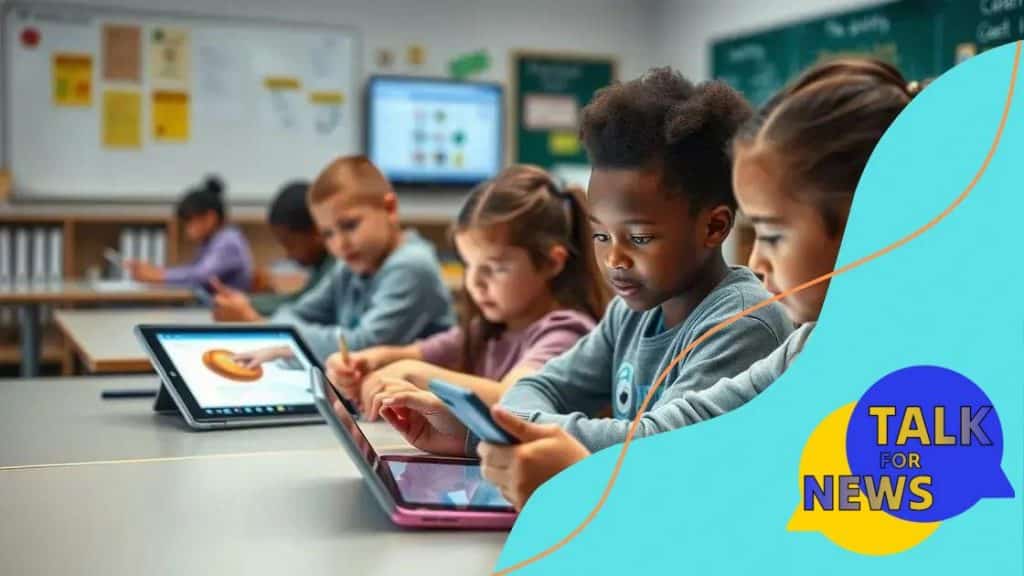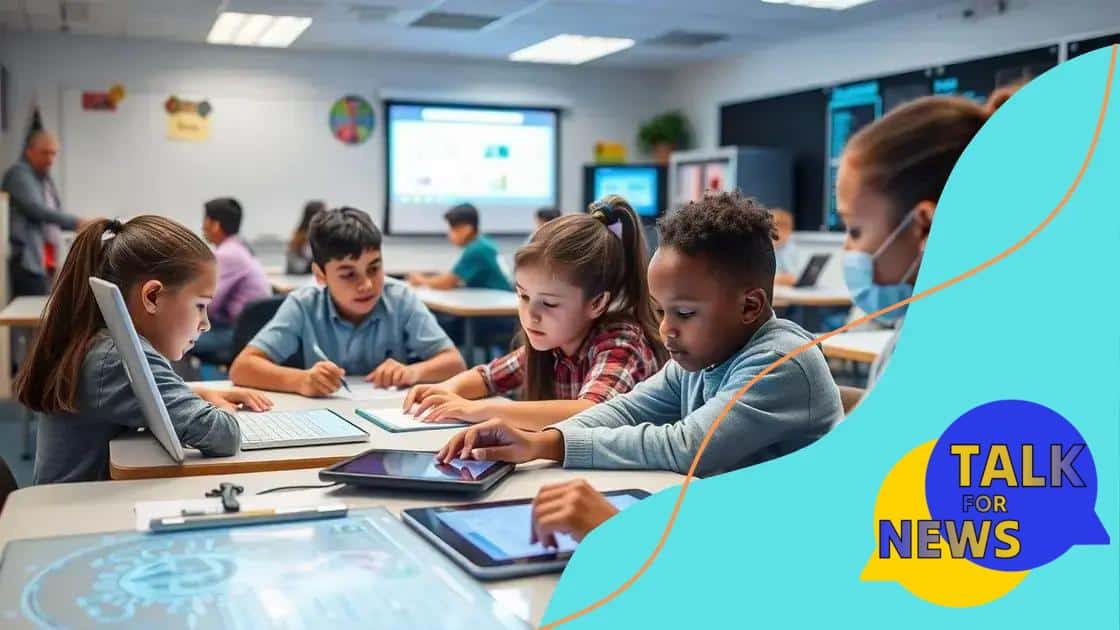How AI-driven personalized education is revolutionizing schools

Anúncios
AI-driven personalized education reshapes schools by customizing learning experiences, enhancing engagement, and preparing students for the future job market while addressing challenges in implementation and equity.
How AI-driven personalized education is reshaping schools and transforming the way students learn. Imagine a classroom where each student receives customized support tailored to their unique needs.
Anúncios
Understanding AI-driven personalized education
Understanding AI-driven personalized education is crucial in grasping how technology reshapes our learning environments. This innovative approach tailors educational experiences to meet individual student needs, promoting better outcomes and engagement.
The Basics of Personalized Education
At its core, personalized education incorporates artificial intelligence to analyze data and adapt learning strategies accordingly. This means that lessons can be customized based on a student’s performance, learning style, and preferences. By leveraging AI, educators can create a dynamic learning atmosphere that fosters student success.
Key Benefits
- Enhanced Engagement: Students are more likely to be invested in their education when it aligns with their interests and strengths.
- Real-Time Feedback: AI systems can provide immediate insights into student progress, allowing for timely interventions.
- Diverse Learning Materials: With AI’s capabilities, resources can be tailored, ensuring that every student has access to materials that suit their level.
- Flexible Learning Paths: Students can progress at their own pace, ensuring mastery of topics before moving on.
Anúncios
The role of teachers evolves too, as they become facilitators and guides rather than just information providers. This shift allows for more meaningful interactions with students, focusing on individual needs.
Additionally, AI-driven tools can assess learning outcomes efficiently. For example, using analytics, schools can identify trends and adjust programs to better serve their students. The goal is not just to improve grades but to foster a love of learning.
Implementing AI in the Classroom
Adopting these technologies comes with challenges, including the need for training educators and integrating new systems. Yet, the potential benefits of personalized education often outweigh these hurdles. Schools must prioritize building a supportive infrastructure that encourages innovation.
Understanding how AI-driven personalized education works can empower educators and students alike. It creates opportunities for a learning experience that is not only effective but also enjoyable and engaging. By embracing this system, we can transform traditional education into something far more responsive to each student’s journey.
Benefits of personalized learning in schools
The benefits of personalized learning in schools are significant and wide-ranging. By tailoring education to fit individual needs, students experience greater engagement, improved academic performance, and enhanced motivation.
Increased Student Engagement
Personalized learning allows students to explore subjects that interest them deeply. When lessons align with their passions, they are more likely to be involved and participate actively. This heightened engagement can lead to a love for learning that extends beyond the classroom.
Improved Academic Performance
Through personalized learning, students receive instruction that matches their learning pace and style. This targeted approach can help them master concepts before moving on to the next topic. As a result, students often achieve higher grades and better test scores. Furthermore, tailored feedback ensures that weaknesses are addressed promptly, supporting a stronger academic foundation.
- Individualized Support: Each student receives specific attention tailored to their unique needs.
- Adaptability: Learning pathways can shift based on ongoing assessment of skills and understanding.
- Encouragement of Critical Thinking: Personalized tasks often challenge students to think critically and solve problems creatively.
Moreover, personalized learning supports diverse learners, including those with special needs and different learning preferences. Educators can provide various resources, from visual aids to hands-on activities, that cater to different styles.
This approach not only benefits students but also enhances the teaching experience. Educators can develop deeper connections with their students, fostering a supportive learning environment. By understanding each student’s strengths and challenges, teachers can facilitate more effective teaching strategies.
Greater Accountability and Ownership
In personalized learning settings, students often take more responsibility for their own learning. They set goals and track their progress, which builds confidence and self-discipline. This ownership of learning is empowering, leading to better outcomes.
This dynamic learning environment emphasizes collaboration, encouraging students to work together on projects while still focusing on their individual goals. Overall, the benefits of personalized learning are clear: it creates an educational experience that is engaging, effective, and supportive.
Real-world applications of AI in the classroom

Exploring real-world applications of AI in the classroom reveals how technology enhances education. Schools around the world are adopting various AI tools to create personalized learning experiences and improve student outcomes.
AI Tutoring Systems
One effective application of AI is in tutoring systems. These platforms use algorithms to analyze student performance and provide tailored lessons. For instance, AI tutors can identify areas where a student struggles and offer specific exercises to address those gaps.
Smart Content Creation
Another exciting use of AI is in content creation. Teachers can generate customized educational materials using AI tools that curate resources based on the curriculum. This way, lessons are more relevant and engaging for students, enhancing their learning experience.
- Data-Driven Insights: AI collects and analyzes data from student interactions, helping educators understand what’s working and what isn’t.
- Adaptive Learning Platforms: These platforms change the learning path based on a student’s performance, providing resources that match their learning needs.
- Virtual Reality Experiences: AI enables immersive learning experiences that transport students to different environments without leaving the classroom.
Teachers also benefit from AI-driven administrative tools. These solutions reduce the time spent on grading and attendance, allowing educators to focus more on teaching and student engagement. By automating tedious tasks, teachers can dedicate more effort to supporting their students.
Additionally, AI facilitates collaboration among students. Tools that connect learners for group projects can analyze each member’s strengths, ensuring balanced participation. This encourages teamwork and enhances social skills.
Real-Time Feedback
AI applications provide real-time feedback to both students and teachers. For example, learning management systems can instantly alert educators about a student’s progress or lack thereof. This immediate data enables timely interventions, ensuring no student falls behind.
The integration of AI in the classroom is not just a trend; it represents a significant shift towards smarter education systems. As technology evolves, we can expect even more innovative applications that will redefine how students learn.
Challenges schools face with AI implementation
Implementing AI in schools presents several challenges that educators and administrators must address. Despite its potential benefits, the adoption of AI technologies can be complex and requires careful consideration.
Financial Constraints
Many schools face significant financial barriers when it comes to adopting AI technologies. Initial costs for AI tools can be high, and budget limitations may prevent schools from investing in the necessary infrastructure. This makes it difficult for some districts to take full advantage of what AI has to offer.
Training and Support
Another challenge is ensuring that teachers and staff are properly trained to use AI tools effectively. Professional development is essential, yet many schools lack the resources to provide ongoing training. Without adequate support, teachers may struggle to integrate AI into their classrooms successfully.
- Resistance to Change: Some educators may be hesitant to adopt new technologies due to a lack of understanding or fear of the unknown.
- Data Privacy Concerns: Protecting student data is crucial, and schools must navigate complex regulations regarding data usage.
- Technological Limitations: Schools may not have the necessary hardware or internet connectivity to implement AI solutions effectively.
Additionally, integrating AI into existing curricula can be challenging. Educators must determine how to incorporate these new tools without disrupting their current teaching methods. This requires thoughtful planning and collaboration among staff to ensure a smooth transition.
Moreover, the effectiveness of AI tools can vary widely. Schools need to carefully evaluate the technologies available and choose those that align with their educational goals. This process can be time-consuming and requires a deep understanding of both the tools and the needs of their students.
Equity Issues
There are also concerns regarding equity in access to AI resources. Students in underfunded schools may not have access to the same technologies as those in wealthier districts. This disparity can widen the achievement gap, making it essential for policymakers to address these inequalities.
Overall, while the implementation of AI in education holds tremendous promise, schools must navigate a variety of challenges to realize its full potential. Addressing financial, training, and equity concerns will be vital as education continues to evolve with technology.
The future of education with AI technology
The future of education with AI technology is bright and full of possibilities. As AI continues to evolve, schools can expect innovative enhancements that transform the learning environment.
Enhanced Learning Experiences
By utilizing AI, schools can customize learning experiences to fit each student’s needs better. AI systems analyze data to recommend personalized learning paths. This means that students can engage with materials that match their interests and learning styles.
Improved Accessibility
With AI tools, educational resources become more accessible. Students with different learning abilities will benefit from tailored content that meets their specific needs. For example, AI can provide speech-to-text for students with hearing impairments or offer advanced support for those who require additional help.
- Scalable Solutions: AI can help teachers manage large classrooms by providing individualized learning experiences for each student.
- Real-Time Assessments: AI allows for immediate feedback on student performance, enabling swift adjustments to teaching strategies.
- Engagement through Interactivity: AI-driven platforms can create engaging and interactive content that captivates students’ attention.
Moreover, the use of AI in schools promotes collaboration among students. AI tools can facilitate group projects by assigning roles based on individual strengths. This not only enhances teamwork but also develops essential social skills.
As AI technology advances, educators will gain more tools to make lessons impactful. Teachers will have access to analytics that help track student progress and identify areas needing focus. The role of the teacher will shift to a facilitator, helping students navigate personalized pathways in their learning journeys.
Preparing for the Future Job Market
Incorporating AI into education prepares students for future job markets, where technology will play a central role. Learning to work with AI tools provides students with valuable skills that will be crucial in the workforce.
The integration of AI technology in education not only enhances the learning experience but also promotes a culture of innovation and adaptability among students. As schools embrace these changes, we can expect a more interactive, inclusive, and effective education system.
In conclusion, the future of education with AI technology offers exciting opportunities for both students and teachers. By creating personalized learning experiences, improving accessibility, and preparing students for the job market, AI has the potential to reshape how we approach education. However, overcoming challenges in implementation and ensuring equitable access will be key to maximizing the benefits of AI in schools. Embracing these changes will help foster a more engaging, effective, and inclusive learning environment for all students.
FAQ – Frequently Asked Questions about AI in Education
How does AI improve personalized learning?
AI analyzes student data to create tailored learning experiences, ensuring that each student gets the support they need.
What challenges do schools face when implementing AI?
Schools often encounter financial constraints, lack of training for teachers, and concerns about data privacy while adopting AI technology.
How can AI enhance student engagement?
By providing interactive and personalized content, AI tools make learning more relevant and interesting, leading to higher student participation.
What skills will students gain from learning with AI technology?
Students will develop critical thinking, problem-solving, and collaboration skills, preparing them for future job markets that utilize technology.





